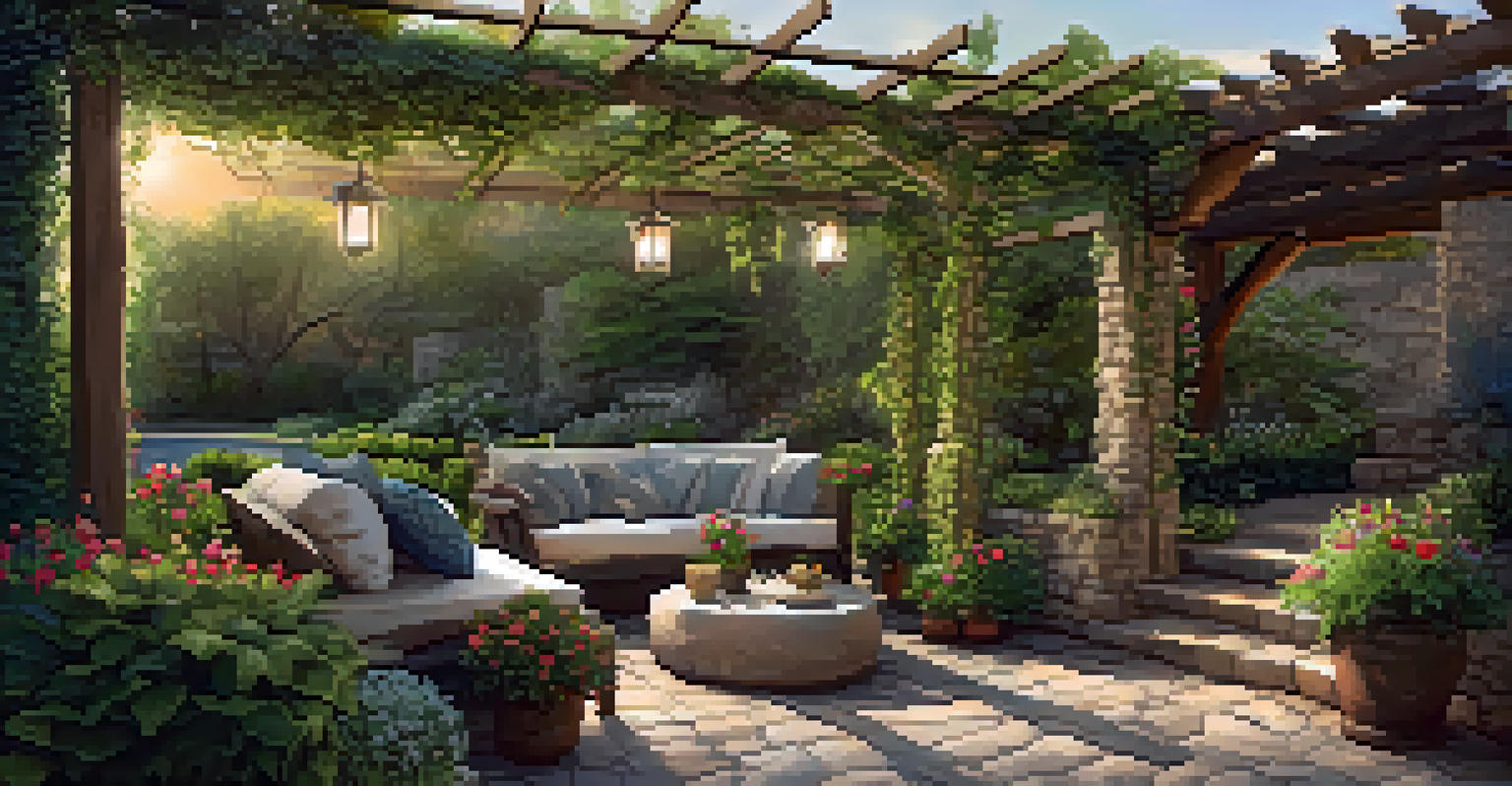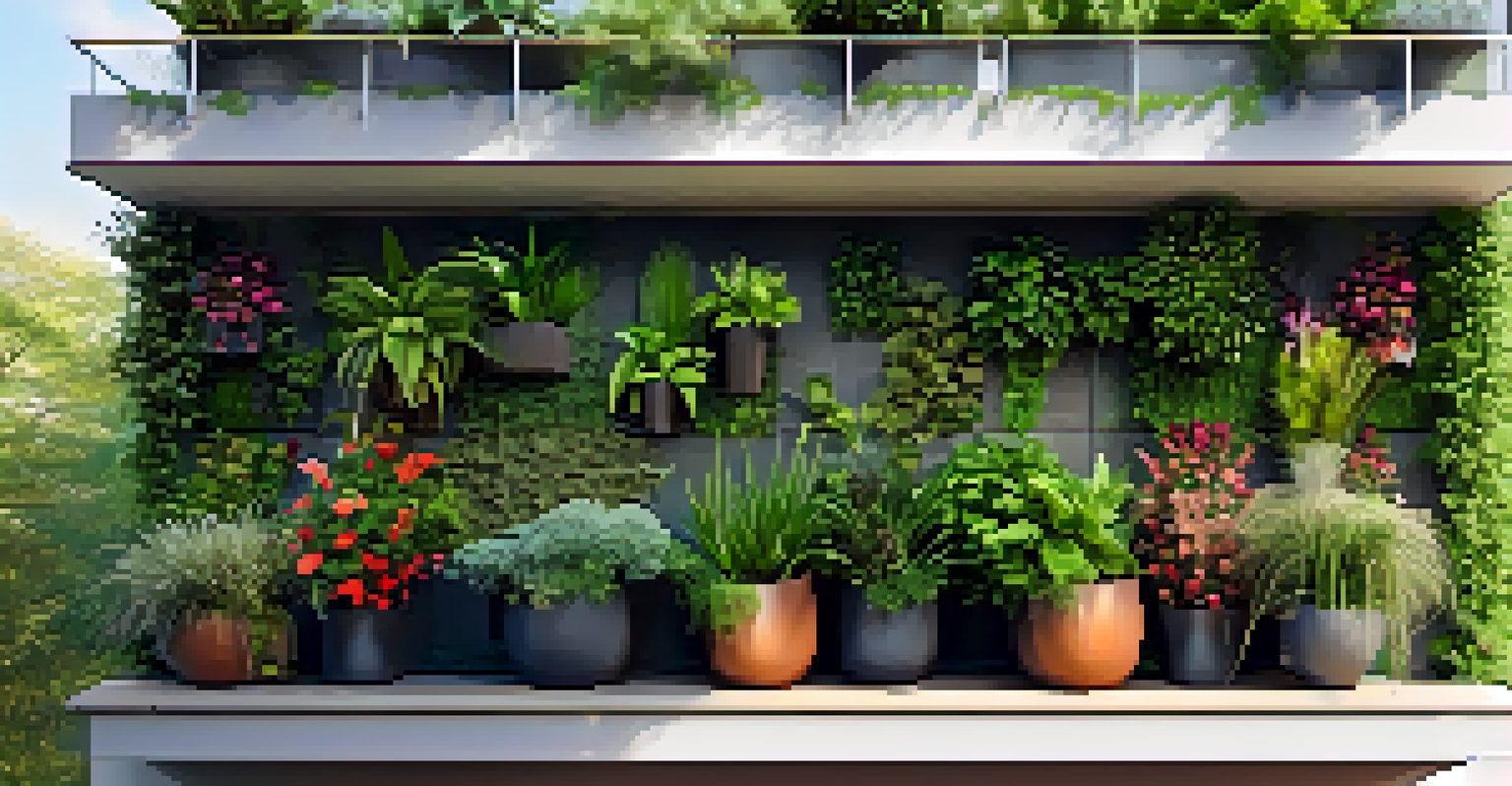Using Plants to Beautify Your Outdoor Living Space

Choosing the Right Plants for Your Space
Selecting the right plants is crucial for beautifying your outdoor area. Consider the climate, sunlight, and soil conditions of your space before making your choice. For example, if you live in a sunny region, you might opt for drought-resistant plants like succulents or lavender, which thrive in bright light.
The love of gardening is a seed once sown that never dies.
Additionally, think about the size of your outdoor area. Smaller spaces can benefit from vertical gardening or container plants that don’t take up too much room. On the other hand, if you have a larger yard, you can explore a mix of shrubs, flowers, and trees to create depth and variety.
Ultimately, choose plants that resonate with your personal style. Whether you prefer vibrant flowers or calming green foliage, the right selection can transform your outdoor living space into a personal oasis.
Creating Layers with Plant Heights
Layering your plants by height creates visual interest and depth in your garden. Start with taller plants at the back or center, then gradually decrease the height as you move forward. This technique not only looks appealing but also ensures that all plants receive adequate sunlight.

For example, if you have a flower bed, you might place towering sunflowers or hollyhocks in the back, with medium-sized marigolds or petunias in the middle, and low-growing ground covers like thyme or creeping phlox at the front. This arrangement leads the eye through the space and makes it feel more inviting.
Choose Plants for Your Environment
Selecting plants that suit your climate, space, and personal style is essential for creating a beautiful outdoor area.
Remember, the key is to create a balanced look that draws attention without overwhelming the space. Mixing textures and colors in your layers can further enhance the beauty of your outdoor area.
Incorporating Color for a Vibrant Space
Color plays a significant role in setting the mood of your outdoor living area. Bright, bold colors can energize the space, while softer, muted tones can create a more serene environment. Consider the color palette that best fits your style and the ambiance you want to achieve.
Gardening adds years to your life and life to your years.
For instance, a garden filled with warm colors like reds, oranges, and yellows can evoke feelings of warmth and happiness, making it perfect for social gatherings. Alternatively, cool colors like blues and purples can offer a calming retreat, ideal for relaxation.
Don't forget to consider seasonal changes as well. Planting a variety of species that bloom at different times throughout the year ensures that your outdoor space remains colorful and lively, no matter the season.
Adding Structure with Hardscaping Elements
While plants are essential for beautifying your outdoor space, hardscaping elements like pathways, patios, and fences can add structure and organization. These features help define different areas within your outdoor space, making it feel more cohesive and functional.
For example, a stone pathway can guide guests through a garden, leading them to a cozy seating area or a fire pit. Meanwhile, a wooden pergola can provide shade and visual interest, enhancing the overall aesthetic of your outdoor living area.
Layer Plants for Visual Appeal
Arranging plants by height creates depth and interest in your garden, ensuring all plants receive adequate sunlight.
Integrating hardscaping with your plants creates a balanced environment where both elements complement each other, making your outdoor area more inviting and enjoyable.
Utilizing Vertical Space for Plant Growth
If you're short on ground space, consider utilizing vertical gardening techniques. Vertical planters, trellises, and wall-mounted pots can all maximize your planting area while adding a unique artistic flair. This approach is particularly beneficial for small patios or balconies.
Climbing plants like ivy or flowering vines can be trained to grow up trellises, creating a lush, green wall that adds privacy and beauty. Additionally, hanging planters filled with herbs or colorful flowers can create a cascading effect that draws the eye upward.
By thinking vertically, you not only maximize your space but also create a dynamic and visually appealing outdoor area that stands out.
Incorporating Edible Plants for Functionality
Mixing ornamental plants with edible varieties is a fantastic way to beautify your outdoor space while also providing fresh produce. Herbs, vegetables, and fruit-bearing plants can add both beauty and utility, making your garden functional and enjoyable.
For example, a raised garden bed filled with colorful heirloom tomatoes, basil, and marigolds can create a stunning visual while providing ingredients for your favorite summer dishes. Likewise, fruit trees can offer shade and delicious fruits, enhancing your outdoor experience.
Blend Edible and Ornamental Plants
Incorporating edible plants alongside ornamental varieties enhances both the beauty and functionality of your outdoor space.
By incorporating these edible plants, you not only enhance the aesthetic appeal of your space but also foster a deeper connection to nature and the food you consume.
Maintaining Your Plant Beautification Efforts
Once you've created your beautiful outdoor space, maintaining it is key to keeping it looking fresh and inviting. Regular watering, pruning, and weeding are essential tasks that will help your plants thrive and maintain their appearance.
Consider setting a routine for garden care, such as dedicating a few hours each week to tending to your plants. This not only keeps your outdoor area in top shape but also allows you to connect with nature and enjoy the process of gardening.

Additionally, consider seasonal changes in your maintenance routine. Different plants may require specific care as the seasons change, so being attentive to their needs will ensure your outdoor space remains beautiful year-round.